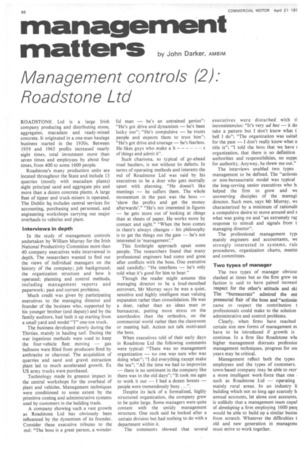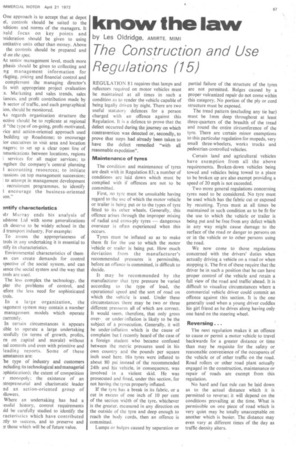management
Page 64

Page 65

If you've noticed an error in this article please click here to report it so we can fix it.
matters by John Darker AMBIM
Management controls (2): Roadstone Ltd
ROADSTONE . Ltd is a large Irish company producing and distributing stone, aggregates, macadam and ready-mixed concrete. It originated in a one-man haulage business started in the 1930s, Between 1959 and 1965 profits increased nearly eight times, total investment more than seven times and employees by about four times, from 400 to some 1600 people.
Roadstone's many production units are located throughout the State and include 13 quarries (mostly with macadam plants) eight principal sand and aggregate pits and more than a dozen concrete plants. A large fleet of tipper and truck-mixers is operated. The Dublin hq includes central services for accounting, purchasing and personnel, and engineering workshops carrying out major overhauls to vehicles and plant.
Interviews in depth In the study of management controls undertaken by William Murray for the Irish National Productivity Committee more than 40 company executives we're interviewed in depth. The researchers wanted to find out the views of individual managers on the history of the company; job background; the organization structure and how it operated; planning and control methods, including management reports and paperwork; past and current problems.
Much credit was given by participating executives to the managing director and founder of the business who, supported by his younger brother (and deputy) and by the family auditors, had built it up starting from a small yard and model "T" one-ton truck.
The business developed slowly during the Thirties, mainly in hauling turf. During the war ingenious methods were used to keep the four-vehicle fleet moving — gas balloons were filled from producers fired by anthracite or charcoal. The acquisition of quarries and sand and gravel extraction plant led to much accelerated growth. Ex US army trucks were purchased.
Technology made its greatest impact in the central workshops for the overhaul of plant and vehicles. Management techniques were conditioned to some extent by the primitive costing and administrative systems used by customers in the building trade.
A company showing such a vast growth as Roadstone Ltd has obviously been influenced by the dynamism of its founder. Consider these executive tributes to the md: "The boss is a great person, a wonder
ful man — he's an untrained genius": "He's got drive.and dynamism — he's been lucky too"; "He's compulsive — he trusts people and expects them to trust him"; "He's got drive and courage — he's fearless.
He likes guys who make a b of things and admit it".
Such charisma, so typical of go-ahead road hauliers, is not without its defects. In terms of operating methods and interests the md of Roadstone Ltd was said by his executives to be a doer who gets mortally upset with planning. "He doesn't like meetings — he suffers them. The whole momentum in the past was the boss — 'show the profits and get the money afterwards'." "He's not interested in figures — he gets more out of looking at things than at sheets of paper. He works more by contact and sight." "When the boss comes in there's always changes — his philosophy is to get the things out the gate — he's not interested in 'management'."
This forthright approach upset some people. The researchers found that many professional engineers had come and gone after conflicts with the boss. One executive said candidly: "He interferes — he's only told what it's good for him to hear."
Though the reader might assume this• managing director to be a loud-mouthed extrovert, Mr Murray says he was a quiet, sensitive and highly intelligent man valuing expansion rather than consolidation. He was a doer, rather than an ideas man or bureaucrat, putting more stress on the unorthodox than the orthodox, on the commercial world rather then the classroom or meeting hall. Action not talk motivated the boss.
When executives told of their early days in Roadstone Ltd the following comments were typical: "There was no management organization — no one was sure who was doing what"; "I did everything except make the tea"; "All the time we had to improvize — there is no sentiment in the company like there was in the old days"; "It took me ages to work it out — I had a dozen bosses — people were tremendously busy. ..".
Despite its lack of a formalized, highly structured organization, the company grew to be quite large. Some managers were quite content with the untidy management structure. One such said he looked after a certain division but had nothing to do with a department within it.
The comments showed that several
executives were disturbed with ti inconsistencies: "It's very ad hoc — it do take a pattern but I don't know what t: hell I do"; "The organization was suitat for the past — I don't really know what n title is"; "I told the boss that we have organization, that there is no definition authorities and responsibilities, no suppc for authority. Anyway, he threw me out."
The interviews enabled two types management to be defined. The "actionis or non-bureaucratic model was typical the long-serving senior executives who helped the firm to grow and we unswerving disciples of the managil director. Such men, says Mr Murray, we characterized by a minimum of rationalii a compulsive desire to move around and s what was going on and "an extremely rar response to stimuli and signals from t managing director".
The professional management typi mainly engineers and accountants, we strongly interested in systems, rule procedures, organization charts, meetin and committees.
Two types of manager The two types of manager obviou: clashed at times but as the firm grew ea faction is said to have gained increasi respect for the other's attitude and ski The "bureaucrats" admired the eat preneurial flair of the boss and "actionisi came to respect the contribution t professionals could make to the solution administrative and control problems.
Clearly, when firms have reached certain size new forms of management m have to be introduced if growth is continue. In a firm like Roadstone whe higher management distrusts professior management techniques, progress for sot years may be critical.
Management reflect both the types employees and the types of customers. town-based company may be able to recr a more intelligent work-force than one such as Roadstone Ltd — operating mainly rural areas. In an industry li building which not so long ago scarcely h annual accounts, let alone cost accounts, is unlikely that a management team capal of developing a firm employing 1600 peot would be able to build up a similar busine from scratch. Whatever the difficulties t old and new generation in manageme must strive to work together. One approach is to accept that at depot el, controls should be suited to the nclitions and norms of the managers. It nuld focus on key points and isideration should be given to using antitative units other than money. Above the controls should be prepared and :c1 on the spot.
At senior management level, much more phasis should be given to collecting and ng management information for rkVing, pricing and financial control and complement the managing director's Is with appropriate project evaluation :s. Marketing and sales trends, sales iances, and profit contribution made by :h sector of traffic, and each geographical ion, should be monitored.
As regards organization structure the ective should be to replicate at regional :1 "the type of on-going, profit-motivated, vice and action-oriented approach used building up Roadstone; to encourage ior executives to visit area and location nagers; to set up a clear open line of nmunications between locations, regions I services for all major services; to :ngthen the company's central planning I accounting resources; to initiate :ussions on top management succession; I to attempt in management development I recruitment programmes, to identify I. encourage the business-oriented son."
entity characteristics
vir Murray ends his analysis of idstone Ltd with some generalizations ch deserve to be widely echoed in the (3 transport industry. For example: To assess the appropriateness of trols in any undertaking it is essential to iffy its characteristics.
Environmental characteristics of themes can create demands for control spective of the social system, and can fence the social system and the way that trots are used.
The less complex the technology, the pier the problems of control, and .efore the less need for sophisticated trols.
In a large organization, the lagement system may contain a number management models which operate currently.
In certain circumstances it appears sible to operate a large undertaking .-,essfully (in terms of growth, profits, rn on capital and morale) without nal controls and even with primitive and leading reports. Some of these umstances are: 'he type of industry and customers ncluding its technological and managerial aphistication); the extent of competition r monopoly; the existence of an ntrepreneurial and charismatic leader nd an action-oriented group of Alowers.
Where an undertaking has had a :essful history, control requirements fld be carefully studied to identify the racteristics which have contributed rAly to success, and to preserve and 31those which will be of future value.












































































































